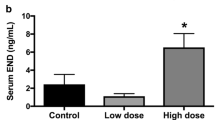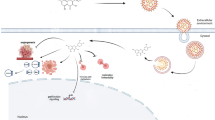Abstract
α-TEA, a nonhydrolyzable ether analog of vitamin E (RRR-α-tocopherol), and celecoxib, a specific COX-2 inhibitor, were delivered separately or in combination to investigate their anticancer properties, using MDA-MB-435-FL-GFP human breast cancer xenografts in nude mice. Liposomal formulated α-TEA administered as an aerosol and celecoxib fed at 500 or 1250 mg/kg diet for 31 days separately or in combination significantly reduced tumor volume in comparison to control (p < 0.001 for all treatment groups). Of special note, the combinations of α-TEA + celecoxib (1250) inhibited tumor volume significantly better than either single treatment (p < 0.001 and p < 0.001). Average number of macroscopic lung metastases were significantly reduced in all treatment groups in comparison to control, with the exception of celecoxib (500). Mean numbers of microscopic lung and lymph node metastases in all treatment groups were significantly lower than control. Furthermore, the mean number of microscopic lung metastases in the α-TEA+celecoxib (1250) group were significantly lower than either separate treatment. Analyses of 5 μm tumor sections showed that all treatments, with the exception of celecoxib (500) alone, significantly enhanced apoptosis (TUNEL) and significantly decreased cell proliferation (Ki-67). α-TEA and α-TEA + celecoxib (1250) treatments significantly reduced blood vessel density (CD-31) in comparison to control. These data show promise for combination α-TEA + celecoxib chemotherapy for breast cancer.
Similar content being viewed by others
References
Jemal A, Tiwari RC, Murray T, Ghafoor A, Samuels A, Ward E, Feuer EJ, Thun MJ: Cancer statistics, 2004. CA Cancer J Clin 54:8–29, 2004
Lawson KA, Anderson K, Menchaca M, Atkinson J, Sun L, Knight V, Gilbert BE, Conti C, Sanders BG, Kline K: Novel vitamin E analogue decreases syngeneic mouse mammary tumor burden and reduces lung metastasis. Mol Cancer Ther 2:437–444, 2003
Shun M-C, Yu W, Gapor A, Parsons R, Atkinson J, Sanders BG, Kline K: Pro-apoptotic mechanisms of action of a novel vitamin E analog (a-TEA)and a naturally occurring form of vitamin E (d-tocotrienol)in MDA-MB-435 human breast cancer cells. Nutr Cancer 48(1):in press
Hwang D, Scollard D, Byrne J, Levine E: Expression of cyclooxygenase-1 and cyclooxygenase-2 in human breast cancer. J Nat Cancer Inst 90:455–460, 1998
Alshafie GA, Abou-Issa HM, Seibert K, Harris RE: Chlemotherapeutic evaluation of cyclooxygenase-2 inhibitor,in a rat mammary tumor model Oncol Rep 7:1377–1381, 2000
Harris RE, Alshafie GA, Abou-Issa H, Seibert K: Chemoprevention of breast cancer in rats by Celecoxib, a cyclooxygenase-2 (COX-2)inhibitor. Cancer Res 60: 2101–2103, 2000
Blumenthal RD, Waskewich C, Goldenberg DM, Lew W, Flefleh C, Burton J: Chronotherapy and chronotoxicity of the cyclooxygenase-2 inhibitor, celecoxib, in athymic mice bearing human breast cancer xenografts. Clin Cancer Res 7: 3178–3185, 2001
Kundu N, Fulton AM: Selective cyclooxygenase (COX)-l or COX-2 inhibitors control metastatic disease in a murine model of breast cancer. Cancer Res 62:2343–2346, 2002
Abou-Issa HM, Alshafie GA, Seibert K, Koki AT, Masferrer JL, Harris RE: Dose-response effects of COX-2 inhibitor, Celecoxib, on the chemoprevention of mammary carcinogenesis. Anticancer Res 21:3425–3432, 2001
Howe LR, Subbaramaiah K, Patel J, Masferrer JL, Deora A, Hudis C, Thaler HT, Muller WJ, Du B, Brown AM, Dannenberg AJ: Celecoxib, a selective cyclooxygenase-2 inhibitor, protects against human epidermal growth factor receptor 2 (HER-2)/neu-induced breast cancer. Cancer Res 62:5405–5407, 2002
Lanza-Jacoby S, Miller S, Flynn J, Gallatig K, Daskalakis C, Masferrer JL, Zweifel BS, Sembhi H, Russo IH: The cyclooxygenase-2 inhibitor, celecoxib, prevents the development of mammary tumors in Her-2/neu mice. Cancer Epidemiol Biomark Prev 12:1486–1491, 2003
Chang S-H, Liu CH, Conway R, Han DK, Nithipatikom K, Trifan OC, Lane TF, Hla T: Role of prostaglandin E2-dependent angiogenic switch in cyclooxygenase-2-induced breast cancer progression. PNAS 101:591–596, 2004
Liu XH, Rose DP: Differential expression and regulation of cyclooxygenase-1 and-2 in two human breast cancer cell lines. Cancer Res 56:5125–5127, 1996
Cuendet M, Pezzuto JM: The role of cyclooxygenase and lipoxygenase in cancer chemoprevention. Drug Metabol Drug Interact 17:109–157, 2000
Soslow RA, Dannenberg AJ, Rush D, Woerner BM, Khan KN, Masferrer J, Koki AT:COX-2 is expressed in human pulmonary, colonic, and mammary tumors. Cancer 89:2637–2645, 2000
Howe LR, Subbaramaiah RK, Brown AMC, Dannenberg AJ:Cyclooxygenase-2:a target for the prevention and treatment of breast cancer. Endocrine Relat Res 8:97–114, 2001
Tsujii M, DuBois RN: Alterations in cellular adhesion and apoptosis in epithelial cells overexpressing prostaglandin endoperoxide synthase 2.Cell 83:493–501, 1995
Liu XH, Kirschenbaum A, Yao S, Lee R, Holland JF, Levine AC: Inhibition of cyclooxygenase-2 suppresses angiogenesis and the growth of prostate cancer in vivo. J Urol 164:820–825, 2000
Masferrer JL, Leahy KM, Koki AT, Zweifel BS, Settle SL, Woerner BM, Edwards DA, Flickinger AG, Moore RJ, Seibert K: Antiangiogenic and antitumor activities of cyclooxygenase-2 inhibitors. Cancer Res 60:1306–1311, 2000
Yu W, Israel K, Liao QY, Aldaz CM, Sanders BG, Kline K: Vitamin E succinate (VES)induces Fas sensitivity in human breast cancer cells: role for Mr 43,000 Fas in VES-triggered apoptosis. Cancer Res 59:953–961, 1999
Knight V, Koshkina NV, Waldrep JC, Giovanella BC, Gilbert BE: Anticancer effect of 9-nitrocamptothecin liposome aerosol on human cancer xenografts in nude mice. Cancer Chemother Pharmacol 44:177–186, 1999
Koshkina NV, Kleinerman ES, Waldrep C, Jia S, Worth LL, Gilbert BE, Knight V:9-Nitrocamptothecin liposome aerosol treatment of melanoma and osteosarcoma lung metastasis in mice. Clin Cancer Res 6:2876–2880,2000
Wang J, Sun L, Myeroff L, Wang X, Gentry LE, Yang J, Lian J, Zborowska E, Markowitz S, Willson JK, et al.: Demonstration that mutation of the type II transforming growth factor beta receptor inactivates its tumor suppressor activity in replication error-positive colon carcinoma cells. J Biol Chem 270:22044–22049, 1995
Weidner N: Intratumor microvessel density as a prognostic factor in cancer. Am J Pathol 147:9–19, 1995
Chow LWC, Wong JLN, Toi M: Celecoxib anti-aromatase neoadjuvant (CAAN)trial for locally advanced breast cancer: preliminary report. J Steroid Biochem Mol Biol 86: 443–447, 2003
Davis TW, O'Neal JM, Pagel MD, Zweifel BS, Mehta PP, Heuvelman DM, Masferrer JL: Synergy between celecoxib and radiotherapy results from inhibition of cyclooxygenase-2-derived prostaglandin E(2),a survival factor for tumor and associated vasculature. Cancer Res 64:279–285, 2004
Chun KS, Kim SH, Song YS, Surh YJ: Celecoxib inhibits phorbol ester-induced expression of COX-2 and activation of AP-1 and p38 MAP kinase in mouse skin. Carcinogenesis 16:16, 2004
Agarwal B, Swaroop P, Protiva P, Raj SV, Shirin H, Holt PR:Cox-2 is needed but not sufficient for apoptosis induced by Cox-2 selective inhibitors in colon cancer cells. Apoptosis 8:649–654, 2003
Sheng GG, Shao J, Sheng H, Hooton EB, Isakson PC, Morrow JD, Coffey Jr RJ, DuBois RN, Beauchamp RD:A selective cyclooxygenase-2 inhibitor suppresses the growth of H-ras-transformed rat intestinal epithelial cells. Gastroenterology 113:1883–1891, 1997
Steinbach G, Lynch PM, Phillips RK, Wallace MH, Hawk E, Gordon GB, Wakabayashi N, Saunders B, Shen Y, Fujimura T, Su LK, Levin B: The effect of celecoxib, a cyclooxygenase-2 inhibitor, in familial adenomatous polyposis. N Engl J Med 342:1946–1952, 2000
Author information
Authors and Affiliations
Rights and permissions
About this article
Cite this article
Zhang, S., Lawson, K.A., Simmons-Menchaca, M. et al. Vitamin E Analog α-TEA and Celecoxib Alone and Together Reduce Human MDA-MB-435-FL-GFP Breast Cancer Burden and Metastasis in Nude Mice. Breast Cancer Res Treat 87, 111–121 (2004). https://doi.org/10.1023/B:BREA.0000041593.69178.57
Issue Date:
DOI: https://doi.org/10.1023/B:BREA.0000041593.69178.57




